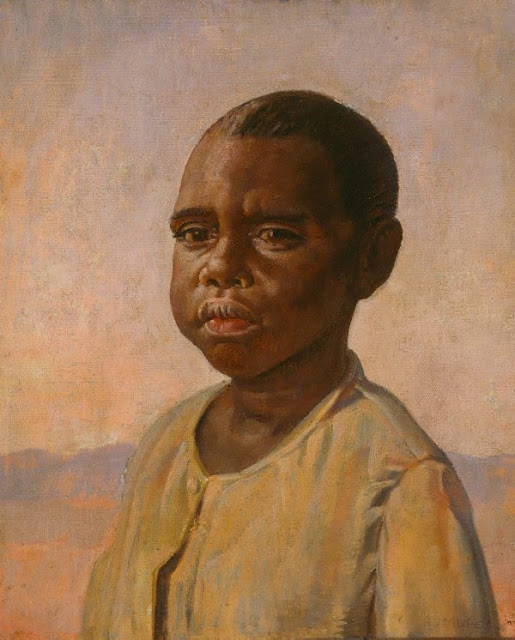Arthur James Murch (1902-1989), painter, sculptor and teacher, was born on 8 July 1902 at Croydon, Sydney, second of three children of English-born parents James Murch, journeyman carpenter, and his wife Caroline Elizabeth, née Holman. Murch’s life reflected many influences from his Methodist upbringing: teetotalism; devotion to family; frugality; a lack of interest in materialism; a love of learning; a strong work ethic; and the ability to build anything from nothing, even his own false teeth. Arthur left Sydney Technical High School, Ultimo, at 15 and became an apprentice at John Heine & Son Ltd, Leichhardt, manufacturers of sheet-metal-working machinery. He was struck in the eye by a steel chip, which later affected his ability to paint outdoors. His drawing skills were noticed and from 1920 he studied part time at the Royal Art Society of New South Wales. In ‘The Foundry’ (exhibited in 1945) he re-created a fiery scene from his engineering years.
Murch was introduced to the impressionistic artists by Antonio Dattilo-Rubbo and in 1924 he joined sculpture classes at East Sydney Technical College under Rayner Hoff. He built a studio in his parents’ backyard and devoted himself full time to art. In 1925 he won the New South Wales Society of Artists’ travelling scholarship; he studied art briefly in Paris at the Académie Julian and in London at the Chelsea Polytechnic, and in depth in Italy, where he fell in love with the Renaissance masters and their classical sources.
On his return to Sydney in 1927 Murch became assistant to George Lambert. Harold Cazneaux’s photograph of them working on a sculpture of an unknown soldier for St Mary’s Cathedral captured their close working relationship. ‘Pocket Hercules’ was Lambert’s apt description of Murch, a diminutive man with a powerful physique. After Lambert’s death in 1930 Murch threw himself into Depression Sydney’s Bohemian art world. But it was from a cottage at coastal Thirroul that the first paintings emerged in the Murch style, in which he fused classical and Renaissance subjects, themes and techniques with Australian people, light and landscape.
In 1933 Professor H. Whitridge Davies invited Murch to accompany a scientific expedition to Central Australia as a freelance artist. His six-week stay at Hermannsburg mission and a camel trek to Mount Liebig resulted in forty-five works exhibited at Macquarie Galleries. Next year he returned to Hermannsburg.
Back in England in 1936, Murch finished painting the shimmering nude ‘Leda’ (1935-39) by candlelight, because his poverty was such that his electricity had been cut off. He created decorations for the Australian wool pavilion at the 1938 Empire Exhibition in Glasgow, Scotland, with the help of (Sir) William Dobell, Donald Friend, Jean Appleton and other Australians. In Sydney again—a return that ‘required considerable adjustment’—he married Gloria (Ria) Mavis Counsell, a copywriter, on 12 September 1940 at Rose Bay Methodist Church. Ria was often the breadwinner; they moved to Sydney’s northern beaches, where living was cheaper and Murch could paint his glorious ‘summery nudes’ and angophoras. He often used his wife and son as models. After Japan entered World War II he was ‘manpowered’ and in July 1942 he was appointed an official war artist; his appointment ended in May 1943 due to illness.
Murch won the 1949 Archibald prize with his portrait of Bonar Dunlop. Murch’s training in engineering and sculpture were particularly evident in his portraits, and his skin tones were unequalled in Australian art. His versatility was evident from his large equestrian sculptures, from murals such as the commissioned ‘The Arts of Peace’ (1951), depicting a Molonga corroboree, and from drawings of his daughter. He inspired the children and adults whom he taught at Avalon, East Sydney Technical College and Hermannsburg. As his palette muddied, so did his fine mind. Survived by his wife and their son and daughter, he died on 23 September 1989 at Terrey Hills and was cremated. His work is held by the National Gallery of Australia, Canberra, and by most State galleries.(Australian Dictionary of Biography)










No comments:
Post a Comment